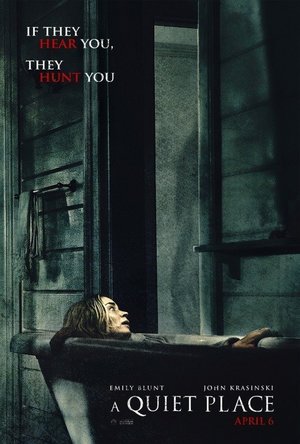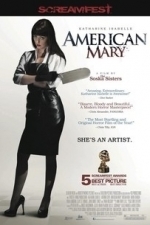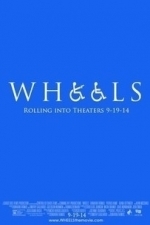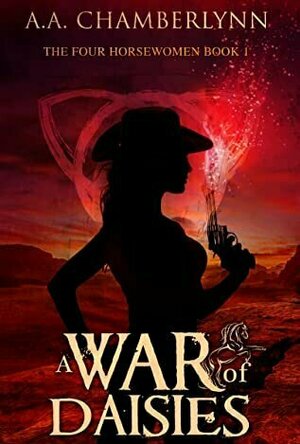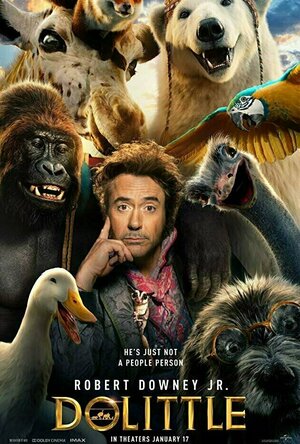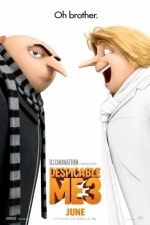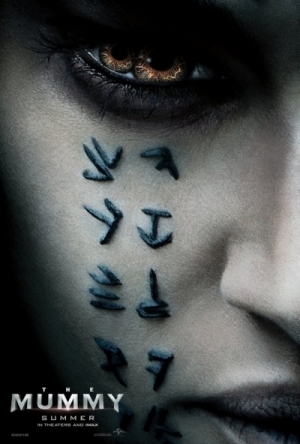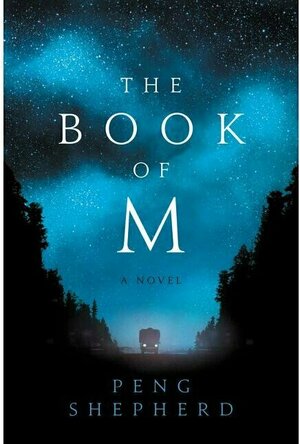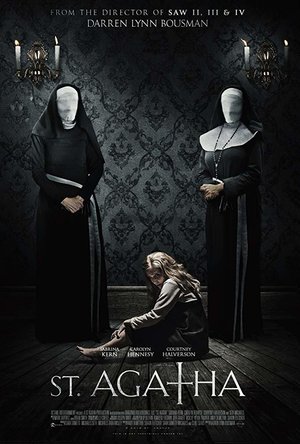Search
Gareth von Kallenbach (980 KP) rated A Quiet Place (2018) in Movies
Jun 19, 2019
Like many parents, Lee (John Krasinski), and Evelyn (Emily Blunt), have an overwhelming urge to keep their children safe in the world and protect them at all costs. In the new film “A Quiet Place”, that maternal drive is taken to extreme levels as the world has been attacked by vicious creatures who hunt by sound alone.
The slightest loud noise will bring a rapid moving creature in moments that will destroy whatever made the sound instantly. As such, Lee and Evelyn have gone to great lengths to live as quietly as possible and even have a system for their home and supply runs to be as safe as possible.
When tragedy strikes, it causes a division between Lee and their only daughter Regan (Millicent Simmonds), who although deaf herself believes she is being blamed for the tragedy and the guilt has only grown over time.
The family continues on and the film jumps forward in time to show that Lee is studying as much about the creatures as he can in an effort to find a weakness they can use as well as to provide more security for his family.
Of course even the best plans do not always work and what follows is a very intense and raw struggle for survival which shows just how far a person is willing to go for their family.
Krasinski not only stars in the film but also directed it and helped to write the screenplay. Working with his actual wife worked very well as they have a fantastic chemistry which helps them convey the emotions and thoughts of the film well which is amazing considering how little dialogue there is in the film as gestures and sign language are the most common form of communication.
The film is very intense in moments and a fantastic extended sequence with Blunt had my wife squeezing my hand tightly and afraid to utter a sound as it left her holding her breath.
The film is a very fresh take on the creature genre and the quality of the performances lifts the film to a level rarely seen in a suspense film. The film did play a bit fast and loose with some aspects such as the history of the creatures and the state of the world around them as it is largely conveyed through newspaper headlines left lying around. As such I found myself wondering why certain defensive options and offensive tactics were not used as to me they seemed to be common sense approaches. For a film with such a fresh premise and strong performances, the ending did seem to depend a bit too much on some of the usual Hollywood stereotypes but it did not keep the film from being highly entertaining and effective. As I watched the film I kept thinking that there could be a connection to “Cloverfield” especially based on aspects of the creatures. The film was made for a very small budget so hopefully we will be seeing a sequel in the near future as “A Quiet Place” was a very enjoyable film and one of the best surprises of the year.
http://sknr.net/2018/04/05/a-quiet-place/
The slightest loud noise will bring a rapid moving creature in moments that will destroy whatever made the sound instantly. As such, Lee and Evelyn have gone to great lengths to live as quietly as possible and even have a system for their home and supply runs to be as safe as possible.
When tragedy strikes, it causes a division between Lee and their only daughter Regan (Millicent Simmonds), who although deaf herself believes she is being blamed for the tragedy and the guilt has only grown over time.
The family continues on and the film jumps forward in time to show that Lee is studying as much about the creatures as he can in an effort to find a weakness they can use as well as to provide more security for his family.
Of course even the best plans do not always work and what follows is a very intense and raw struggle for survival which shows just how far a person is willing to go for their family.
Krasinski not only stars in the film but also directed it and helped to write the screenplay. Working with his actual wife worked very well as they have a fantastic chemistry which helps them convey the emotions and thoughts of the film well which is amazing considering how little dialogue there is in the film as gestures and sign language are the most common form of communication.
The film is very intense in moments and a fantastic extended sequence with Blunt had my wife squeezing my hand tightly and afraid to utter a sound as it left her holding her breath.
The film is a very fresh take on the creature genre and the quality of the performances lifts the film to a level rarely seen in a suspense film. The film did play a bit fast and loose with some aspects such as the history of the creatures and the state of the world around them as it is largely conveyed through newspaper headlines left lying around. As such I found myself wondering why certain defensive options and offensive tactics were not used as to me they seemed to be common sense approaches. For a film with such a fresh premise and strong performances, the ending did seem to depend a bit too much on some of the usual Hollywood stereotypes but it did not keep the film from being highly entertaining and effective. As I watched the film I kept thinking that there could be a connection to “Cloverfield” especially based on aspects of the creatures. The film was made for a very small budget so hopefully we will be seeing a sequel in the near future as “A Quiet Place” was a very enjoyable film and one of the best surprises of the year.
http://sknr.net/2018/04/05/a-quiet-place/
Darren (1599 KP) rated American Mary (2013) in Movies
Jun 20, 2019
Story: Key words here original, clever and dark all these make this something very special. It fuses different motives for each character instead of just using one motive to drive them. Once you have seen this story you will always remember it too. (9/10)
Actor Review: Katharine Isabelle – Mary who enters the world of body modification. Great performances in which she stays calm in every situation which is needed to create a very impressive character. Very haunting character and a welcome addition to horror icons. Star Performance Award (9/10)
mary
Actor Review: Antonio Cupo – Billy club owner and seemingly small time gangster who helps Mary to complete her jobs. Good character which slowly becomes the only moral compass in the film. (7/10)
billy
Actor Review: Tristen Risk – Beatress a lady who spends all her money on making herself into a fictional character. Very quirky character which you will remember once you have first seen her on the screen and hears her voice. (8/10)
beatirce
Actor Review: David Lovgren – Doctor Grant a Doctor who expects the best from his students but also takes advantage of them. Typical take advantage Doctor does enough to drive Mary to the next stage of her spiral into the underworld. Good performance and creates a character that is meant to be disliked. (7/10)
grant
Actor Review: Paula Lindberg – Ruby Realgirl who has presidia done to turn her into a doll. The extremes this character goes to and the final reveal off the work is something you will remember. (8/10)
Director Review: Jen Soska, Sylvia Soska – The second film by the Twisted Twins and this time they step up to a new level giving an original story with some very memorable scenes. (9/10)
Cameo by the Twisted Twins
Cameo by the Twisted Twins
Horror: A welcome addition to the horror genre with some very disturbing scenes. (9/10)
Thriller: Very good build using revenge filled suspense for some actions as well as good suspense to see what Mary will do next. (9/10)
Special Effects: There are some brilliant special effects used to create that body modifications. (9/10)
Believability: People will do some very strange things to their body so you could say this is quite believable. (8/10)
Chances of Tears: No (0/10)
Settings: Most of the film is set between two locations, Mary’s apartment and a metal strip club for alternative music fans. Both work as this shows the two main places Mary works and makes her money. (8/10)
Suggestion: In the world of horror it is very unusual to see something different. This is that something different and once you have seen it you will remember it. I suggest all horror fans must watch this as it is one of the most original films to come out in a very long time. (Watch)
Best Part: Mary’s revenge on Doctor Grant.
Kill Of The Film: Security guard as it shows how far Mary has gone.
Oscar Chances: No
Chances of Sequel: No
Overall: Dark, delicious and brilliant
https://moviesreview101.com/2014/01/17/american-mary-2012/
Actor Review: Katharine Isabelle – Mary who enters the world of body modification. Great performances in which she stays calm in every situation which is needed to create a very impressive character. Very haunting character and a welcome addition to horror icons. Star Performance Award (9/10)
mary
Actor Review: Antonio Cupo – Billy club owner and seemingly small time gangster who helps Mary to complete her jobs. Good character which slowly becomes the only moral compass in the film. (7/10)
billy
Actor Review: Tristen Risk – Beatress a lady who spends all her money on making herself into a fictional character. Very quirky character which you will remember once you have first seen her on the screen and hears her voice. (8/10)
beatirce
Actor Review: David Lovgren – Doctor Grant a Doctor who expects the best from his students but also takes advantage of them. Typical take advantage Doctor does enough to drive Mary to the next stage of her spiral into the underworld. Good performance and creates a character that is meant to be disliked. (7/10)
grant
Actor Review: Paula Lindberg – Ruby Realgirl who has presidia done to turn her into a doll. The extremes this character goes to and the final reveal off the work is something you will remember. (8/10)
Director Review: Jen Soska, Sylvia Soska – The second film by the Twisted Twins and this time they step up to a new level giving an original story with some very memorable scenes. (9/10)
Cameo by the Twisted Twins
Cameo by the Twisted Twins
Horror: A welcome addition to the horror genre with some very disturbing scenes. (9/10)
Thriller: Very good build using revenge filled suspense for some actions as well as good suspense to see what Mary will do next. (9/10)
Special Effects: There are some brilliant special effects used to create that body modifications. (9/10)
Believability: People will do some very strange things to their body so you could say this is quite believable. (8/10)
Chances of Tears: No (0/10)
Settings: Most of the film is set between two locations, Mary’s apartment and a metal strip club for alternative music fans. Both work as this shows the two main places Mary works and makes her money. (8/10)
Suggestion: In the world of horror it is very unusual to see something different. This is that something different and once you have seen it you will remember it. I suggest all horror fans must watch this as it is one of the most original films to come out in a very long time. (Watch)
Best Part: Mary’s revenge on Doctor Grant.
Kill Of The Film: Security guard as it shows how far Mary has gone.
Oscar Chances: No
Chances of Sequel: No
Overall: Dark, delicious and brilliant
https://moviesreview101.com/2014/01/17/american-mary-2012/
Kirk Bage (1775 KP) rated Wheels (2014) in Movies
Mar 3, 2020 (Updated Mar 12, 2020)
According to the film’s IMDb page, this low budget indie production, filmed in Los Angeles is the greatest film of all time! A month ago it sat at 9.3, which is better than The Godfather and The Shawshank Redemption! As I am writing and compiling a book about the best 200 films of the 21st century, up to the end of 2019, I was obliged to check this out. With almost 18,000 votes to its name, there must be something in it being rated that highly, right?
Well, obviously not. Someone smart behind the film, listed variously as a 2014 or 2017 production, depending on where you look, had clearly gone out of their way to manipulate its online presence in the hope of gaining viewers. Look, it worked – I watched it, and now I’m writing about it. Pretty shameful really, as you find that almost no website has a bad review or rating for it out there; it has pretty much been scrubbed clean. How they did it, I do not know, but it is indefensible to be honest. The real shame being that it isn’t a bad film for the budget at all, and may have got more views and respect the old fashioned way.
The story revolves around a recently paralysed man becoming suicidal and finding another guy in a wheelchair to ask if he will blow his brains out with a gun. From there the two go on a rampage of drug addiction, self harm and anti-social misbehaviour. For every cliche in there, there is another moment which is quite well done, and although you can see the cracks here and there it is mostly a watchable and enjoyable film, with some laughs and some genuine emotion. Acting wise, the two leads (writer and co-director Donavon Warren and Patrick Hume) have their moments too; perhaps lacking anything hugely inciteful, but certainly competent enough to compare favourably to some higher profile movies.
Ultimately, it is merely fine. Not something you would recommend or especially remember, but not a complete waste of 2 hours either. It is clearly going for the idea that disabled people are helpless victims on its head, and does largely succeed in not condescending or amping up the pity. That doesn’t stop either of them being unlikable people, however – perhaps that is the point.
More interesting than the film by far is how these guys manipulated the publicity system to get it seen. So many films worth seeing drift into obscurity for lack of money, take the films of Shane Caruth, Primer and Upstream Color. Both incredible, original and intelligent movies that no one saw, and only word of mouth many years later puts them on anyone’s radar. Then there are the endless festival films that do the rounds and can’t pick up distribution, no matter how good. Perhaps a film like Wheels needs to employ these kind of tactics to survive. It is really a question of ethics. I have to say, as an honest reviewer, it does bother me that fake ratings and reviews can exist and slip under the wire. But maybe that is just me…?
Well, obviously not. Someone smart behind the film, listed variously as a 2014 or 2017 production, depending on where you look, had clearly gone out of their way to manipulate its online presence in the hope of gaining viewers. Look, it worked – I watched it, and now I’m writing about it. Pretty shameful really, as you find that almost no website has a bad review or rating for it out there; it has pretty much been scrubbed clean. How they did it, I do not know, but it is indefensible to be honest. The real shame being that it isn’t a bad film for the budget at all, and may have got more views and respect the old fashioned way.
The story revolves around a recently paralysed man becoming suicidal and finding another guy in a wheelchair to ask if he will blow his brains out with a gun. From there the two go on a rampage of drug addiction, self harm and anti-social misbehaviour. For every cliche in there, there is another moment which is quite well done, and although you can see the cracks here and there it is mostly a watchable and enjoyable film, with some laughs and some genuine emotion. Acting wise, the two leads (writer and co-director Donavon Warren and Patrick Hume) have their moments too; perhaps lacking anything hugely inciteful, but certainly competent enough to compare favourably to some higher profile movies.
Ultimately, it is merely fine. Not something you would recommend or especially remember, but not a complete waste of 2 hours either. It is clearly going for the idea that disabled people are helpless victims on its head, and does largely succeed in not condescending or amping up the pity. That doesn’t stop either of them being unlikable people, however – perhaps that is the point.
More interesting than the film by far is how these guys manipulated the publicity system to get it seen. So many films worth seeing drift into obscurity for lack of money, take the films of Shane Caruth, Primer and Upstream Color. Both incredible, original and intelligent movies that no one saw, and only word of mouth many years later puts them on anyone’s radar. Then there are the endless festival films that do the rounds and can’t pick up distribution, no matter how good. Perhaps a film like Wheels needs to employ these kind of tactics to survive. It is really a question of ethics. I have to say, as an honest reviewer, it does bother me that fake ratings and reviews can exist and slip under the wire. But maybe that is just me…?
Debbiereadsbook (1617 KP) rated A War of Daisies (The Four Horsewomen of the Apocalypse #1) in Books
Jan 5, 2021
a book that takes you out of your usual comfort zone, and it does it in such a way, you do NOT see it coming!
Independent reviewer for Archaeolibrarian, I was gifted my copy of this book.
There comes along, once in a rare while, a book that takes you out of your usual comfort zone, and it does it in such a way, you do NOT see it coming! This is such a book!
I read the blurb, it sounded interesting, but I really wasn't expecting to be blown away, and so much so, I was reading this book at 3.30am, cos I coulnd't put it down!
All four women have a say, and for their time, they have a LOT to say. They are all are feeling repressed and held down, for one reason or other, and it takes time for those reasons to fully become clear. Once all four are together in one place, a freak weather storm leaves them with powers, and those powers will get them what they what: freedom.
Freedom, however, comes at a price. And its that price, that TWIST that I did not see coming! I love being puddled along, you know? Taking my time, enjoying what I'm reading, a few questions lurking, but not really seeing where this is going, or that it'll be a 5 star read. And then BAM, right near the end, things become clear, many questions are answered, and then many MORE pop up. The four womens lives are drawn into a tighter circle, and their roles become a bit more solid, but still I'm not sure where this is gonna go!
Some things happened here that I did not see coming, and I loved being proven wrong about things, even if the reality on the page is far worse than I thought.
There is, apart from that bit I just mentioned, no romance in this book, but there is violence. The women are, afterall, War, Pestilence, Famine and Death. But it's not graphic, at all,but written in such a way that you don't see it coming at ya, not at first. When things become a little clearer, then you do see it coming, but again, written in such a great way!
It's been a long time since I tried to write a gushing review without giving anything away, but I think I managed it here. Had I gone into too much detail, I think the womens secrets would have been told, and you need to discover them in the pages of the book, I think, for you to fully appreciate them.
Written with all the words and customs and attitudes of the time (1894, United States) it throws up some *AH* moments and some *NOOOOOOOOOOO? really? they did that?* moments and some *oh my gosh, they did NOT!* moments, and I loved them all!
In case you didn't get it, I loved this book! I hope I can get my grubby mitts on the next one!
5 full and shiny stars
**same worded review will appear elsewhere**
There comes along, once in a rare while, a book that takes you out of your usual comfort zone, and it does it in such a way, you do NOT see it coming! This is such a book!
I read the blurb, it sounded interesting, but I really wasn't expecting to be blown away, and so much so, I was reading this book at 3.30am, cos I coulnd't put it down!
All four women have a say, and for their time, they have a LOT to say. They are all are feeling repressed and held down, for one reason or other, and it takes time for those reasons to fully become clear. Once all four are together in one place, a freak weather storm leaves them with powers, and those powers will get them what they what: freedom.
Freedom, however, comes at a price. And its that price, that TWIST that I did not see coming! I love being puddled along, you know? Taking my time, enjoying what I'm reading, a few questions lurking, but not really seeing where this is going, or that it'll be a 5 star read. And then BAM, right near the end, things become clear, many questions are answered, and then many MORE pop up. The four womens lives are drawn into a tighter circle, and their roles become a bit more solid, but still I'm not sure where this is gonna go!
Some things happened here that I did not see coming, and I loved being proven wrong about things, even if the reality on the page is far worse than I thought.
There is, apart from that bit I just mentioned, no romance in this book, but there is violence. The women are, afterall, War, Pestilence, Famine and Death. But it's not graphic, at all,but written in such a way that you don't see it coming at ya, not at first. When things become a little clearer, then you do see it coming, but again, written in such a great way!
It's been a long time since I tried to write a gushing review without giving anything away, but I think I managed it here. Had I gone into too much detail, I think the womens secrets would have been told, and you need to discover them in the pages of the book, I think, for you to fully appreciate them.
Written with all the words and customs and attitudes of the time (1894, United States) it throws up some *AH* moments and some *NOOOOOOOOOOO? really? they did that?* moments and some *oh my gosh, they did NOT!* moments, and I loved them all!
In case you didn't get it, I loved this book! I hope I can get my grubby mitts on the next one!
5 full and shiny stars
**same worded review will appear elsewhere**
Emma @ The Movies (1786 KP) rated Dolittle (2020) in Movies
Mar 5, 2020
More CGI animals in another adaptation of a franchise that has been around since the 1920s. I do so love Eddie Murphy's comedy portrayal, am I ready for a period appropriate version?
Tommy Stubbins isn't like his uncle, he doesn't want to hunt the animals in the wood. When he shoots wide in an attempt to miss his target he accidentally hits a squirrel, but his reaction makes his uncle and cousin leave him there with the injured animal. Clutching the squirrel and not knowing what to do Tommy finds himself being beckoned by a parrot. She leads him through a gap in a high stone wall to an expanse filled with (not so) wild animals.
Doctor Dolittle has been hidden behind closed doors ever since his wife disappeared. With just the animals for company he's forgotten some of his human manners, he must remember them quickly as he's summoned by the Queen who is gravely ill.
Welsh. That accent that you couldn't quite put your finger on, that was Welsh... yeah, it wouldn't have been my first guess either but let's just accept it and move on shall we?
Seeing the CGI on this in the trailer didn't annoy me, and looking back now I'm not sure how that was the case when Call Of The Wild basically the same thing and I was livid. Just like Call Of The Wild, Dolittle benefits from the comedy you can get from the CGI and it really needed that.
RDJ is a big ticket name, but I'm not entirely sure he was suited to the role of John Dolittle. Perhaps that's partly to do with the fact that so much of his recent history is dominated by him as Tony Stark, perhaps it's because the slightly crazy and vulnerable Dolittle in this film has little impact. The truth for me is probably somewhere in the middle.
Considering the live action section of the films features a lot of Tommy Stubbins (played by Harry Collett) his role seems of little consequence after he's taken us to the estate, after all, Lady Rose would still have gone there and I suspect Polly would have steered him right. Stubbins, in the books, narrates the stories after he first appears, but in this adaptation it's given to Polly, voiced by Emma Thompson. I can understand that decision, she's got a very soothing and yet commanding voice that's perfect for that role.
There seems to be a lot of pieces kept from the books, though they've been tweaked for the modern audience. Not only the change of narrator but Polly is no longer a grey African parrot, instead we're given a much brighter macaw which has a better visual payoff.
One day I'll remember to look at the cast list for animated films before I go in, trying to place voices is so difficult on the fly. All in all the animals are fine, the script doesn't feel great but the antics help it out somewhat.
Our villains are quite varied throughout but Michael Sheen takes a main role as Dr. Blair Müdfly, Dolittle's rival. The interactions between him and the animals did amuse me but his over the top nature that built steadily through the film felt much too cliche, sadly not always in an entertaining way.
There are many things to like hidden in the film. It opens with a great animation that gives us back story which allows us not to suffer through clumsy attempts at the same during the film. I also really enjoyed the way we're shown how Dolittle speaks to the animals, though that does raise other questions that make things unravel, so I'll move on. The squirrel's commentary is hilarious and probably makes him my favourite character, though the octopus isn't too far behind.
Dolittle has a lot of nice little touches but it relies heavily on predictable humour and at times doesn't know when to stop (I'm thinking specifically about a scene towards the end of the film here). Even with its many ups and downs the film was enjoyable to watch, just the once. I'm entirely convinced that with a different accent it would have been infinitely better.
Originally posted on: https://emmaatthemovies.blogspot.com/2020/03/dolittle-movie-review.html
Tommy Stubbins isn't like his uncle, he doesn't want to hunt the animals in the wood. When he shoots wide in an attempt to miss his target he accidentally hits a squirrel, but his reaction makes his uncle and cousin leave him there with the injured animal. Clutching the squirrel and not knowing what to do Tommy finds himself being beckoned by a parrot. She leads him through a gap in a high stone wall to an expanse filled with (not so) wild animals.
Doctor Dolittle has been hidden behind closed doors ever since his wife disappeared. With just the animals for company he's forgotten some of his human manners, he must remember them quickly as he's summoned by the Queen who is gravely ill.
Welsh. That accent that you couldn't quite put your finger on, that was Welsh... yeah, it wouldn't have been my first guess either but let's just accept it and move on shall we?
Seeing the CGI on this in the trailer didn't annoy me, and looking back now I'm not sure how that was the case when Call Of The Wild basically the same thing and I was livid. Just like Call Of The Wild, Dolittle benefits from the comedy you can get from the CGI and it really needed that.
RDJ is a big ticket name, but I'm not entirely sure he was suited to the role of John Dolittle. Perhaps that's partly to do with the fact that so much of his recent history is dominated by him as Tony Stark, perhaps it's because the slightly crazy and vulnerable Dolittle in this film has little impact. The truth for me is probably somewhere in the middle.
Considering the live action section of the films features a lot of Tommy Stubbins (played by Harry Collett) his role seems of little consequence after he's taken us to the estate, after all, Lady Rose would still have gone there and I suspect Polly would have steered him right. Stubbins, in the books, narrates the stories after he first appears, but in this adaptation it's given to Polly, voiced by Emma Thompson. I can understand that decision, she's got a very soothing and yet commanding voice that's perfect for that role.
There seems to be a lot of pieces kept from the books, though they've been tweaked for the modern audience. Not only the change of narrator but Polly is no longer a grey African parrot, instead we're given a much brighter macaw which has a better visual payoff.
One day I'll remember to look at the cast list for animated films before I go in, trying to place voices is so difficult on the fly. All in all the animals are fine, the script doesn't feel great but the antics help it out somewhat.
Our villains are quite varied throughout but Michael Sheen takes a main role as Dr. Blair Müdfly, Dolittle's rival. The interactions between him and the animals did amuse me but his over the top nature that built steadily through the film felt much too cliche, sadly not always in an entertaining way.
There are many things to like hidden in the film. It opens with a great animation that gives us back story which allows us not to suffer through clumsy attempts at the same during the film. I also really enjoyed the way we're shown how Dolittle speaks to the animals, though that does raise other questions that make things unravel, so I'll move on. The squirrel's commentary is hilarious and probably makes him my favourite character, though the octopus isn't too far behind.
Dolittle has a lot of nice little touches but it relies heavily on predictable humour and at times doesn't know when to stop (I'm thinking specifically about a scene towards the end of the film here). Even with its many ups and downs the film was enjoyable to watch, just the once. I'm entirely convinced that with a different accent it would have been infinitely better.
Originally posted on: https://emmaatthemovies.blogspot.com/2020/03/dolittle-movie-review.html
Lee (2222 KP) rated Despicable Me 3 (2017) in Movies
Jul 14, 2017
Time to stop making these now
The original Despicable Me is a firm favourite in our house. If we come across it while channel hopping, it usually stays on until the end and still manages to raise plenty of laughs. The second Despicable Me was OK, but not very memorable. The Minions movie was a train wreck, and proved that they’re at their best when in short bursts and as part of someone else’s movie. And now we have a third Despicable Me, which continues the trend set by the second of just being OK, but now with the added feeling that they really should stop making these.
A news report introduces us to 80s TV child star Balthazar Bratt. After a successful run of his own TV show, things went badly wrong for Balthazar when puberty hit and the squeaky voice and zits resulted in Hollywood ditching his show. Balthazar disappeared from the public eye and the report then asks the question ‘where is he now?’. Cut to the ocean, and a diamond heist on a ship which, if you’ve seen the relevant trailer, means you’ve pretty much seen the entire scene. Balthazar uses bubblegum as a weapon, along with a keytar, and enjoys tackling his enemies with 80s inspired dance fights. The scene ends with Gru, naked and caught up in the bubblegum, embarrassing himself as he floats through the city for all to see while a couple of minions enjoy themselves at a beach party. Yep, pretty much the whole original trailer has just played for us.
Gru and Lucy both find themselves sacked from the Anti-Villain league for failing to capture Balthazar during the heist but they don’t have long to think about what to do next before Gru discovers that he has a twin brother called Dru, that he knew nothing about. Dru got to live with his dad while Gru got to live with his mum following their parents split. They all then head off to Freedonia for a family reunion.
The rest of the movie is pretty much a big mess, with far too many dull and pointless subplots. The main story involves the two brothers, getting to know each other and eventually teaming up to recover the diamond from Balthazar once again and to finally capture him. But this is all at the expense of pretty much every other character in the movie. The Minions have already gone off on their own subplot, having left Gru to go in search of a more villain-like life. Ending up in jail, they soon decide that they miss Gru, so break out in order to try and get back to him in time for the end of the movie. And as for the girls – Agnes is on the hunt for a unicorn, because a bloke in the pub said there was one in the woods, Margo is trying to avoid a local boy who has a crush on her and Edith just doesn’t really feature very much at all. And after briefly helping Gru out at the start of the movie, the main focus for Lucy throughout the rest of the movie is to try and be accepted as a mum to the three girls.
The final act, with the brothers working together to stop Balthazar from getting his revenge and making a big mess in Hollywood, is fairly entertaining, and the Minions still manage to raise big laughs in pretty much every scene they feature, but overall this was pretty disappointing.
A news report introduces us to 80s TV child star Balthazar Bratt. After a successful run of his own TV show, things went badly wrong for Balthazar when puberty hit and the squeaky voice and zits resulted in Hollywood ditching his show. Balthazar disappeared from the public eye and the report then asks the question ‘where is he now?’. Cut to the ocean, and a diamond heist on a ship which, if you’ve seen the relevant trailer, means you’ve pretty much seen the entire scene. Balthazar uses bubblegum as a weapon, along with a keytar, and enjoys tackling his enemies with 80s inspired dance fights. The scene ends with Gru, naked and caught up in the bubblegum, embarrassing himself as he floats through the city for all to see while a couple of minions enjoy themselves at a beach party. Yep, pretty much the whole original trailer has just played for us.
Gru and Lucy both find themselves sacked from the Anti-Villain league for failing to capture Balthazar during the heist but they don’t have long to think about what to do next before Gru discovers that he has a twin brother called Dru, that he knew nothing about. Dru got to live with his dad while Gru got to live with his mum following their parents split. They all then head off to Freedonia for a family reunion.
The rest of the movie is pretty much a big mess, with far too many dull and pointless subplots. The main story involves the two brothers, getting to know each other and eventually teaming up to recover the diamond from Balthazar once again and to finally capture him. But this is all at the expense of pretty much every other character in the movie. The Minions have already gone off on their own subplot, having left Gru to go in search of a more villain-like life. Ending up in jail, they soon decide that they miss Gru, so break out in order to try and get back to him in time for the end of the movie. And as for the girls – Agnes is on the hunt for a unicorn, because a bloke in the pub said there was one in the woods, Margo is trying to avoid a local boy who has a crush on her and Edith just doesn’t really feature very much at all. And after briefly helping Gru out at the start of the movie, the main focus for Lucy throughout the rest of the movie is to try and be accepted as a mum to the three girls.
The final act, with the brothers working together to stop Balthazar from getting his revenge and making a big mess in Hollywood, is fairly entertaining, and the Minions still manage to raise big laughs in pretty much every scene they feature, but overall this was pretty disappointing.
Movie Metropolis (309 KP) rated The Mummy (2017) in Movies
Jun 10, 2019
A new franchise is reborn
It seems that the Marvel Cinematic Universe has kicked off a trend over in tinseltown. Shared franchises are all the rage at the moment, and why not. Marvel has taken over $10billion. DC has finally found its footing with Wonder Woman and Legendary are fusing Godzilla with Kong: Skull Island to create their own monster universe.
But for every success story there is a failed series that didn’t quite grab the cinema-going public with The Golden Compass and The Last Airbender immediately springing to mind. Nevertheless, Universal Pictures has pushed ahead with creating its own ‘Dark Universe’. Proceedings kick off with The Mummy. But how does this reboot fare?
Nick Morton (Tom Cruise) is a soldier of fortune who plunders ancient sites for timeless artefacts and sells them to the highest bidder. When Nick and his partner (Jake Johnson) come under attack in the Middle East, the ensuing battle accidentally unearths Ahmanet, a betrayed Egyptian princess (Sofia Boutella) who was entombed under the desert for thousands of years. With her powers constantly evolving, Morton must now stop the resurrected monster as she embarks on a furious rampage through the streets of London.
First-time director and long-time screenwriter Alex Kurtzman crafts a film that moves at breakneck speed, features a lot of nifty set-pieces and is an intriguing precursor to the next instalment of the franchise. It’s pretty good fun to be honest.
Tom Cruise is as reliable as ever, and does all the Tom Cruise staples; running, heavy breathing, shirtless preening, but the stand-out performance here is Russell Crowe’s Dr. Henry Jekyll (yes, that’s right). Despite being slightly underused, Crowe is a fantastic choice to play this multi-layered character. Elsewhere, Sofia Boutella is very good as Ahmanet.
Unfortunately, Jake Johnson (Jurassic World) and Cruise’s love interest Annabelle Wallis (King Arthur: Legend of the Sword) feel miscast with Wallis in particular having no believable chemistry with her co-star.
To look at The Mummy is first-rate. Gone are the campy special effects of the Brendan Fraser-era films, instead replaced with crisp CGI – though the dark and gloomy filming style hampers the obviously great effects. Nevertheless, the aircraft and subsequent crash sequences that have been marketed in the trailers are gripping and produced very well indeed.
Unfortunately, The Mummy relies heavily on jump scares, of which there are far too many, and the trade-off for that rollercoaster pace is a film that feels disjointed, relying on visually stunning action sequences to cover over cracks in the story. Some of the humour also falls flat.
Ultimately though, these are small gripes in a vastly entertaining popcorn flick that is a very solid starting point to a series that will include films like The Invisible Man, Bride of Frankenstein and The Wolfman.
Whilst not the most original film you will see this year, The Mummy opens up some intriguing doors and whilst I’m in no rush to see it again, despite its competence, I’m excited to see how Universal will bring all of their iconic monsters back to the big screen in one unified franchise.
https://moviemetropolis.net/2017/06/10/a-new-franchise-is-reborn-the-mummy-review/
But for every success story there is a failed series that didn’t quite grab the cinema-going public with The Golden Compass and The Last Airbender immediately springing to mind. Nevertheless, Universal Pictures has pushed ahead with creating its own ‘Dark Universe’. Proceedings kick off with The Mummy. But how does this reboot fare?
Nick Morton (Tom Cruise) is a soldier of fortune who plunders ancient sites for timeless artefacts and sells them to the highest bidder. When Nick and his partner (Jake Johnson) come under attack in the Middle East, the ensuing battle accidentally unearths Ahmanet, a betrayed Egyptian princess (Sofia Boutella) who was entombed under the desert for thousands of years. With her powers constantly evolving, Morton must now stop the resurrected monster as she embarks on a furious rampage through the streets of London.
First-time director and long-time screenwriter Alex Kurtzman crafts a film that moves at breakneck speed, features a lot of nifty set-pieces and is an intriguing precursor to the next instalment of the franchise. It’s pretty good fun to be honest.
Tom Cruise is as reliable as ever, and does all the Tom Cruise staples; running, heavy breathing, shirtless preening, but the stand-out performance here is Russell Crowe’s Dr. Henry Jekyll (yes, that’s right). Despite being slightly underused, Crowe is a fantastic choice to play this multi-layered character. Elsewhere, Sofia Boutella is very good as Ahmanet.
Unfortunately, Jake Johnson (Jurassic World) and Cruise’s love interest Annabelle Wallis (King Arthur: Legend of the Sword) feel miscast with Wallis in particular having no believable chemistry with her co-star.
To look at The Mummy is first-rate. Gone are the campy special effects of the Brendan Fraser-era films, instead replaced with crisp CGI – though the dark and gloomy filming style hampers the obviously great effects. Nevertheless, the aircraft and subsequent crash sequences that have been marketed in the trailers are gripping and produced very well indeed.
Unfortunately, The Mummy relies heavily on jump scares, of which there are far too many, and the trade-off for that rollercoaster pace is a film that feels disjointed, relying on visually stunning action sequences to cover over cracks in the story. Some of the humour also falls flat.
Ultimately though, these are small gripes in a vastly entertaining popcorn flick that is a very solid starting point to a series that will include films like The Invisible Man, Bride of Frankenstein and The Wolfman.
Whilst not the most original film you will see this year, The Mummy opens up some intriguing doors and whilst I’m in no rush to see it again, despite its competence, I’m excited to see how Universal will bring all of their iconic monsters back to the big screen in one unified franchise.
https://moviemetropolis.net/2017/06/10/a-new-franchise-is-reborn-the-mummy-review/
Goddess in the Stacks (553 KP) rated The Book of M in Books
Sep 7, 2018
What defines a person? Your experiences? Your personality? The emotional bonds you forge? What happens when you forget? Are you still you if you don't remember who that is? The Book of M tackles these questions and takes an intimate look at what happens when some people forget but others remember.
We enter on Max and Ory in an abandoned hotel, running out of food and supplies. Max has lost her shadow, which means she will soon start forgetting. Everything. (There are rumors that Shadowless have died because they forgot to breathe or eat.) We learn it's been a few years since the phenomenon started happening, and flashbacks tell us the story of those early months. Like any good dystopia, it is a world-altering process. Governments are gone because no one remembered to run them. Food and other supplies are dwindling because farmers, shippers, manufacturers forgot what they were doing and how to do it.
But with the forgetting comes - magic, of a sort. Ory comes across a deer in the forest that instead of antlers, has wings sprouting from its forehead. Because someone forgot that deer shouldn't have wings - and so it happened. Forgetting that something can be destroyed can make it indestructible. Forgetting that you left a place can take you back to that place. Forgetting a place exists can make that place no longer exist. It's not a very controllable kind of magic. And it's dangerous - you can never be quite sure what you'll forget, and you can affect other people with it.
And the forgetting starts with losing your shadow. Ory gives Max a tape recorder, so she can record things she might forget. He posts signs around their hideout to remind her of things, like "Let no one in. Ory has a key." and "Don't touch the guns or the knives." But Max knows she is a danger to Ory, and so while she can still remember enough to function, she runs away.
The book mostly concerns Ory and Max's journeys across the country; Max trying to find something she's forgotten, and Ory trying to find Max. The adventure is gripping, heartbreaking, and at times confusing. (Mostly on Max's end, as magic warps things around her.) There are a few side characters who also have viewpoint chapters. Naz Ahmadi is an Iranian girl training for the Olympics in the US - in archery, which comes in quite handy. We also have The One Who Gathers, a mysterious man in New Orleans who has gathered a flock of shadowless.
If you ever played the roleplaying game Mage: the Ascension, and remember the concept of Paradox, this book reminds me of that a lot. (Is it a surprise that I'm a tabletop RPG geek? It shouldn't be. I own almost all of the old World of Darkness books, and currently play in a D&D game, and hopefully soon a second D&D game!) Anyway. Paradox. Where doing magic too far outside the bounds of acceptable reality punishes you, so you have to weigh the potential consequences against the magic you want to do.
I really enjoyed this debut novel; it is a very original take on a dystopia, and raised a lot of questions about personality, memories, and what makes a person the person you remember.
You can find all my reviews at http://goddessinthestacks.com
We enter on Max and Ory in an abandoned hotel, running out of food and supplies. Max has lost her shadow, which means she will soon start forgetting. Everything. (There are rumors that Shadowless have died because they forgot to breathe or eat.) We learn it's been a few years since the phenomenon started happening, and flashbacks tell us the story of those early months. Like any good dystopia, it is a world-altering process. Governments are gone because no one remembered to run them. Food and other supplies are dwindling because farmers, shippers, manufacturers forgot what they were doing and how to do it.
But with the forgetting comes - magic, of a sort. Ory comes across a deer in the forest that instead of antlers, has wings sprouting from its forehead. Because someone forgot that deer shouldn't have wings - and so it happened. Forgetting that something can be destroyed can make it indestructible. Forgetting that you left a place can take you back to that place. Forgetting a place exists can make that place no longer exist. It's not a very controllable kind of magic. And it's dangerous - you can never be quite sure what you'll forget, and you can affect other people with it.
And the forgetting starts with losing your shadow. Ory gives Max a tape recorder, so she can record things she might forget. He posts signs around their hideout to remind her of things, like "Let no one in. Ory has a key." and "Don't touch the guns or the knives." But Max knows she is a danger to Ory, and so while she can still remember enough to function, she runs away.
The book mostly concerns Ory and Max's journeys across the country; Max trying to find something she's forgotten, and Ory trying to find Max. The adventure is gripping, heartbreaking, and at times confusing. (Mostly on Max's end, as magic warps things around her.) There are a few side characters who also have viewpoint chapters. Naz Ahmadi is an Iranian girl training for the Olympics in the US - in archery, which comes in quite handy. We also have The One Who Gathers, a mysterious man in New Orleans who has gathered a flock of shadowless.
If you ever played the roleplaying game Mage: the Ascension, and remember the concept of Paradox, this book reminds me of that a lot. (Is it a surprise that I'm a tabletop RPG geek? It shouldn't be. I own almost all of the old World of Darkness books, and currently play in a D&D game, and hopefully soon a second D&D game!) Anyway. Paradox. Where doing magic too far outside the bounds of acceptable reality punishes you, so you have to weigh the potential consequences against the magic you want to do.
I really enjoyed this debut novel; it is a very original take on a dystopia, and raised a lot of questions about personality, memories, and what makes a person the person you remember.
You can find all my reviews at http://goddessinthestacks.com
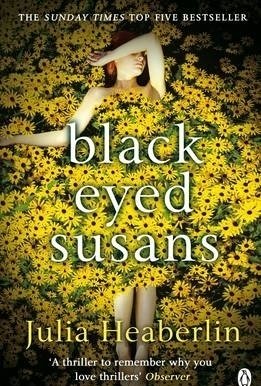
Black-Eyed Susans
Book
**THE TOP 5 SUNDAY TIMES BESTSELLER** 'My book of the year so far. Breathtakingly, heart-stoppingly...
Darren (1599 KP) rated St. Agatha (2018) in Movies
Oct 2, 2019
Characters – Mary is a pregnant young lady with a tragic past which saw her running from her abusive father, she seeks refuge to have her child, which sees her in a convent, only for this to be a worse hell than her previous life, she is stuck with the abusive religious nuns that want her baby, even renaming her Agatha. Mother Superior runs the convent, she has strict rules and expects the women to follow these rules or face punishment, she does however want the children to be born, which means the punishments won’t put the babies at risks, she has women under her control, but when it comes to Mary she must go to new extremes to keep her position of power in place. Catherine is one of the few women that offers Mary any help within the walls, she is also pregnant further along than Mary, meaning the two teaming up would mean more risk for her. We do have other girls that are under different levels of control, while we also have other nuns who are trying to prove their level of strictness to the Mother Superior.
Performances – Sabrina Kern in the leading role is great to watch, she brings the broken figure and shows us just how determined she is to make the most out of her life with her child. Carolyn Hennessy does bring us the strict figure required for her role which will show how capable to she to take control of the scenes through the film. the rest of the cast do a solid job throughout, they each get their moment to shine in the film’s story too.
Story – The story follows a young woman who seeks refuge in a convent to help her have her child only to find the convent is being controlled by nuns that don’t always follow the bible when it comes to helping the young women that come to them for help. With this story we do get to give until the personal life of Mary that does have a tragic past and does show how far she has had to go to fix the problems in her life. The main focus is on the convent which does keep us guessing to what the Mother Superior will do next because they want the babies and can’t risk damaging them, but do need to punish the women. We do get elements of the theme around the idea of cults which does play an important factor in just where the film ends up going. We also have women at different stages of pregnancy which shows us and Mary just what will happen to her if she stays.
Horror – The horror in the film follows the events in the convent, we get a mix of hauntings and torture, which are only making Mary look like she is losing her mind.
Settings – The film is set in the convent, we get to see how the locked doors keep people in and just how they are going to be forcing the woman to follow the rules.
Special Effects – The effects in this film are used to show the injuries which aren’t as graphic as they could have been, though they imply horrific injuries given.
Scene of the Movie – The baby is coming.
That Moment That Annoyed Me – It could have gone a lot darker that is does go.
Final Thoughts – This is a solid enough horror that uses the themes of religious cults to make the horror seem more realistic and shocking.
Overall: Religious Cult 101
Performances – Sabrina Kern in the leading role is great to watch, she brings the broken figure and shows us just how determined she is to make the most out of her life with her child. Carolyn Hennessy does bring us the strict figure required for her role which will show how capable to she to take control of the scenes through the film. the rest of the cast do a solid job throughout, they each get their moment to shine in the film’s story too.
Story – The story follows a young woman who seeks refuge in a convent to help her have her child only to find the convent is being controlled by nuns that don’t always follow the bible when it comes to helping the young women that come to them for help. With this story we do get to give until the personal life of Mary that does have a tragic past and does show how far she has had to go to fix the problems in her life. The main focus is on the convent which does keep us guessing to what the Mother Superior will do next because they want the babies and can’t risk damaging them, but do need to punish the women. We do get elements of the theme around the idea of cults which does play an important factor in just where the film ends up going. We also have women at different stages of pregnancy which shows us and Mary just what will happen to her if she stays.
Horror – The horror in the film follows the events in the convent, we get a mix of hauntings and torture, which are only making Mary look like she is losing her mind.
Settings – The film is set in the convent, we get to see how the locked doors keep people in and just how they are going to be forcing the woman to follow the rules.
Special Effects – The effects in this film are used to show the injuries which aren’t as graphic as they could have been, though they imply horrific injuries given.
Scene of the Movie – The baby is coming.
That Moment That Annoyed Me – It could have gone a lot darker that is does go.
Final Thoughts – This is a solid enough horror that uses the themes of religious cults to make the horror seem more realistic and shocking.
Overall: Religious Cult 101
